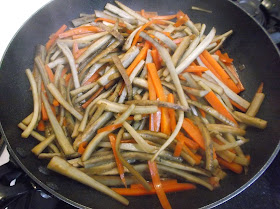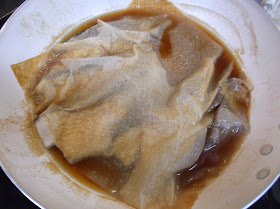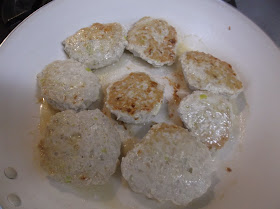The main dish (shusai) of our supper last Monday was store-bought beef korokke (Japanese croquette), except for my wife, who prefers kabocha korokke, and one side dish (fukusai) was Chinese cabbage salad. I thought what I would make for another side dish. I remembered having bought one bag of kiriboshi daikon the day before, so I decided to make simmered kiriboshi daikon.
30 g kiriboshi daikon, rinsed under running water in a sieve
1/2 carrot, cut into julienne
10-20 g(?) pre-sliced dried shiitake, rinsed under running water in sieve
1 abura age, cut in half lengthwise first and then cut into strips
Put all the ingredients in a pot, add enough water to barely cover them, bring to a boil, add 1-2 tsp sugar, simmer for 3 min., add 1 tsp instant dashi and some soy sauce, and simmer for another 3 min.
The total cooking time is about 10 min.
今週の月曜の夕飯のメインディッシュ(主菜)は、市販のビーフコロッケでした(かぼちゃコロッケのほうが好きな妻を除いて)。一つの副菜は白菜のサラダで、他の
副菜は何にしようか考えました。切り干し大根を1袋、前日に買ったのを思い出したので、切り干し大根の煮物を作ることにしました。
切り干し大根 30 g。ざるに入れ、流水で洗う。
にんじん 1/2本。千切り。
切ってある干しシイタケ 10~20 g。ざるに入れ、流水で洗う。
油揚げ 1枚。まず縦に半分に切ってから細切りにする。
材料をすべて鍋に入れ、水をひたひたになるまで入れ、沸騰させ、砂糖を小さじ1~2入れ、3分煮て、出汁の素を小さじ1、しょう油を少々入れて、さらに3分煮る。
調理時間は全部で10分程です。
You may have noticed that I didn't reconstitute the kiriboshi daikon or the dried shiitake and I didn't remove excess oil from the abura age. I used to follow these steps, but not any longer. The resultant dish is good enough.
切り干し大根と干しシイタケを水で戻してないし、油揚げの油抜きもしてないことに気付いたかも知れません。昔はやっていましたが、もうやっていません。できた料理は十分美味しいです。
Note that one main dish (shusai) and two side dishes (fukusai), in addition to rice and soup, are common elements of a Japanese meal.
メインディッシュ(主菜)1つとおかず(副菜)2つに、ご飯とお汁が日本の食事の一般的な要素です。




















































